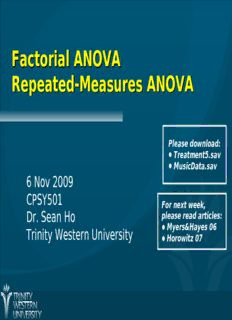Table Of ContentFFaaccttoorriiaall AANNOOVVAA
RReeppeeaatteedd--MMeeaassuurreess AANNOOVVAA
Please download:
● Treatment5.sav
● MusicData.sav
6 Nov 2009
CPSY501
For next week,
Dr. Sean Ho please read articles:
● Myers&Hayes 06
Trinity Western University
● Horowitz 07
OOuuttlliinnee ffoorr TTooddaayy
Factorial ANOVA
● Running in SPSS and interpreting output
● Main effects and interactions
● Follow-up analysis: plots & simple effects
Repeated-Measures ANOVA
● Assumptions: parametricity, sphericity
● Follow-up analysis: post-hoc comparisons
CPSY501: Factorial and RM ANOVA 6 Nov 2009
IInnttrroo ttoo FFaaccttoorriiaall AANNOOVVAA
ANOVA with multiple “between-subjects” IVs
Describe number of categories/groups per IV:
● “5 x 4 x 4 design” means 3 IVs, with
5 values (groups), 4 values, 4 values each
Each cell is a combination of categories:
● 5 x 4 x 4 = 80 cells
● Each participant goes in exactly one cell,
and is measured only once on the DV
● Cells are assumed to be independent
● “Balanced”: cell sizes all equal
CPSY501: Factorial and RM ANOVA 6 Nov 2009
WWhhyy FFaaccttoorriiaall AANNOOVVAA??
Why not just do One-way on each IV?
● IVs may have shared variance
● Interaction effects (moderation)!
Main effects: effect of just one IV (One-way)
Two-way interaction: Effects of one IV change
depending on value of another IV (moderator)
3-way and higher interactions exist, too
Higher-order effects supercede low-order ones:
interpret the highest significant interaction
Graphs may be needed to understand them
CPSY501: Factorial and RM ANOVA 6 Nov 2009
OOuuttlliinnee ffoorr TTooddaayy
Factorial ANOVA
● Running in SPSS and interpreting output
● Follow-up procedures
● Interactions, main effects, & simple effects
● Examples
Repeated-Measures ANOVA
● Assumptions, sphericity
● Follow-up analysis: post-hoc comparisons
CPSY501: Factorial and RM ANOVA 6 Nov 2009
FFaaccttoorriiaall AANNOOVVAA iinn SSPPSSSS
First check assumptions (see later slides)
Analyze → GLM → Univariate
● Enter all IVs together in “Fixed Factor(s)”
● Model: “Full Factorial” (default)
(checks for all main effects & interactions)
● Options: Effect size & Homogeneity tests,
Descriptives (and later, marginal means)
Examine each effect in the model separately
Treatment5.sav: IVs: Treatment Type, Gender
● DV: just depression at outcome for now
CPSY501: Factorial and RM ANOVA 6 Nov 2009
IInntteerrpprreettiinngg OOuuttppuutt:: TTrreeaattmmeenntt55
There were significant effects for treatment type,
F (2, 21) = 21.14, p < .001, η2 = .668, and gender,
F (1, 21) = 14.69, p = .001, η2 = .412, but
no significant interaction, F (2, 21) = 0.15,
Tests of Between-Subjects Effects
p > .05, η2 = .014
Dependent Variable: depression levels at outcome of thera py
Type III Sum Partial Eta
Source of Squares df Mean Square F Sig. Squared
Corrected Mode l
55.796(a) 5 11.159 11.431 .000 .731
Intercept
317.400 1 317.400 325.141 .000 .939
Gender 14.341 1 14.341 14.691 .001 .412
Treatmnt 41.277 2 20.638 21.142 .000 .668
Gender * Treatmn t .283 2 .142 .145 .866 .014
Error
20.500 21 .976
Total
383.000 27
Corrected Tota l
76.296 26
CPSY501: Factorial and RM ANOVA 6 Nov 2009
a R Squared = .731 (dAjusted R Squared = .667 )
OOuuttlliinnee ffoorr TTooddaayy
Factorial ANOVA
● Running in SPSS and interpreting output
● Follow-up procedures
● Interactions, main effects, & simple effects
● Examples
Repeated-Measures ANOVA
● Assumptions, sphericity
● Follow-up analysis: post-hoc comparisons
CPSY501: Factorial and RM ANOVA 6 Nov 2009
FFoollllooww--uupp AAnnaallyyssiiss:: MMaaiinn eeffffeeccttss
If there are significant main effects:
● Analyze → GLM → Univariate → Post-hoc
● Post-hoc tests as in one-way ANOVA
● SPSS does post-hoc for each IV separately
(i.e., as if doing multiple one-way ANOVAs)
Report means and SDs for each category of
each significant IV (Options: Descriptives)
Or report marginal means for “unique effects”
(Options: Estimated Marginal Means)
(more on this momentarily)
CPSY501: Factorial and RM ANOVA 6 Nov 2009
PPoosstt--hhoocc:: TTrreeaattmmeenntt55
Post-hoc on main effect for Treatment Type:
● Levene's is not significant, so can choose a
post-hoc test that assumes equal variance:
e.g., Tukey's HSD
No post-hocs needed for Gender – why?
Output on next slide:
● The Wait List control group has significantly
higher depression levels at post-treatment
● (can graph means to visualize)
CPSY501: Factorial and RM ANOVA 6 Nov 2009
Description:○Main effects and interactions. ○Follow-up analysis: plots & simple effects. Repeated-Measures ANOVA. ○Assumptions: parametricity, sphericity.

